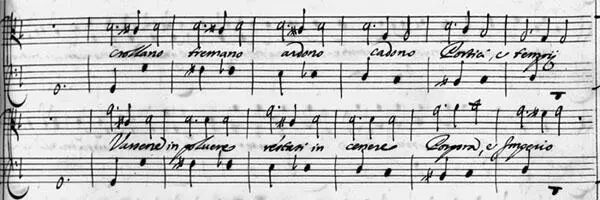When Monteverdi died, in 1643, Francesco Cavalli, a gifted protégé, took his place. No less than his mentor had, Cavalli shaped the opera genre as we know it today, perfecting the transition from speechlike recitative to fully lyrical arioso singing. He had a particular gift for arias of lament, embedding them in velvety harmonic progressions. An early example appears in the 1640 opera Gli amori d’Apollo edi Dafne, which tells of Daphne’s transformation into a laurel tree. Toward the end, the god Apollo realizes that his beloved nymph has slipped from his grasp, and he declares himself miserable. Cavalli promptly unfurls the A-G-F-E bass line from Lamento della ninfa, making it the motor of a truncated arioso passage that bears the title Lamento:

As in Monteverdi, the repetition in the bass mimics the obsessive, circular thinking of the unhappy lover—the painful recollection of happy moments, the sick-hearted imagining of alternate outcomes. It follows the psychological rhythm of depression: the spirit sinking step by step, straining to recover, then sinking again.
The Venetian public evidently enjoyed Apollo’s monologue of misery, for Didone, Cavalli’s opera for the following season, features laments galore. In the first act, survivors of the fall of Troy—Hecuba, King Priam’s widow; her daughters Cassandra and Creusa; and the hero Aeneas, Creusa’s husband—bewail the end of their world even as more mayhem descends on them. Cassandra has hardly finished mourning for her beloved Coroebus when Creusa is abruptly slain. Hecuba enters, seeking to voice a feeling “beyond the tears,” and she finds release in an incantation that seems to portray not only the recent fall of Troy but also the future demise of Greece:
Porticos, temples are
Shaking and trembling,
Burning and tumbling.
Purple and empire,
Turn into dust,
Make clothes of ashes!
At this point Cavalli had a stroke of genius, one that reverberated through the centuries. He prolonged Monteverdi’s ostinato bass, so that it moved down by chromatic steps (G–F-sharp–F-natural–E–E-flat–D). There’s something claustrophobic about those close-set intervals: they give the feeling of a dismal shuffle, the gait of a lost soul.

The laments of Didone come mainly from the throats of women: Cassandra and Hecuba in the first act, Dido at the end. Almost from the start, male opera composers depended on the figure of the abandoned, vengeful, and/or maddened female. The musicologist Susan McClary, in her pioneering study Feminine Endings, identifies Monteverdi’s Lamento della ninfa as a harbinger of operatic mad scenes, describing the piece as “a display designed by men, chiefly for the consumption of other men.” McClary compares the music to a grille on an old asylum window through which passersby could watch mad people. Other scholars, though, have detected a certain defiant self-assertion in the female portraits set forth by Cavalli and other early operatic composers. Wendy Heller, in a discussion of Didone, describes the title character as a tragically constrained woman, but celebrates Hecuba as an intriguingly dangerous force of nature, her music charged with “a sense of the supernatural and the other-worldliness of [her] strength.”
The singer and composer Barbara Strozzi (1619–77), one of the few publicly recognized female composers of the Baroque period, reversed the standard equation in her cantata L’Eraclito amoroso (“The Amorous Heraclitus”). The text for this piece shows the Greek philosopher Heraclitus in a perpetual fit of despondency:
My only pleasure is in weeping,
I feed on tears alone.
Dolor is my delight,
And my joy is sighing.
Strozzi presumably sang the cantata herself, impersonating a male in extremis. An ornate vocal line unfolds over a steady iteration of the Lamento della ninfa bass. It is an ambiguous, even androgynous scene, with gender identity melting away into a purely musical space of lamentation. For Strozzi, as for Dowland, melancholy may have been a site of self-creation, even giving hints of future freedom.
FRENCH AND ENGLISH CHACONNES
The chaconne had its apotheosis at Versailles. The music master at the court of Louis XIV was Jean-Baptiste Lully, who, like the chaconne itself, came from lowly circumstances; the son of a Florentine miller, he started out laboring as a servant and tutor to a princess who was a cousin of the king. When Lully exhibited performing talent, Louis hired him as a dancer, and shortly after set him to work composing. Lully created a series of grand ballets that he and Louis danced side by side; in later years, he became the chief opera composer of the kingdom, his clout confirmed by his friendship with the sovereign and his scandalous homosexual affairs largely excused. Productions at Versailles were so staggeringly lavish that many in the audience came principally to see the theatrical machinery. Plots were taken from mythology and chivalric tales, with unhappy endings modified to meet the harmonious ideals of the Sun King’s world.
Lully’s theater works routinely culminate in a majestic chaconne or passacaille. The flowing motion of these dances symbolizes the reconciliation of warring elements and the restoration of happiness. At the same time, an exotic association remains; a scholarly study by Rose Pruiksma notes that Lully’s chaconnes and passacailles are linked to Italian, Spanish, North African, even Chinese characters and locales. In Cadmus, a chaconne is performed by “thirteen Africans dancing and playing the guitar.” In Armide, a four-note passacaglia bass stands for the sorcery of the title character. And in the Ballet d’Alcidiane, from 1658, the union of the island princess and the hero Polexandre prompts a Chaconne des Maures, or Chaconne of the Moors. Louis himself performed as one of eight Moorish dancers, donning a black mask. The verses for the scene invoke the irresistible attraction of the darker-skinned males:
One dreads the arms of these lovely shadowed ones
And everything gives way to their charms,
Blondes, I say farewell to you.
As Pruiksma explains, the sight of world cultures happily intermingling provided a mythological justification for Louis XIV’s marriage into the Spanish Habsburg family in 1660. Given the Hispanic origins of the chaconne, the music fit the occasion.
In these same years, the chaconne underwent its epic mutation, taking on a markedly more serious visage. Other dances of the day evolved in much the same way: the racy zarabanda became the stately sarabande, a medium of sober reflection for the likes of J. S. Bach and George Frideric Handel. Composers seemed to compete among themselves to see who could most effectively distort and deconstruct the popular music of the seventeenth century. They must have done so in a spirit of intellectual play, demonstrating how the most familiar stuff could be creatively transformed; such is the implicit attitude of Frescobaldi’s Partite sopra ciaccona and Cento partite. Louis Couperin, a keyboard composer of questing intellect, carried on the game by writing chaconnes that, in the words of Wilfrid Mellers, “proceed with relentless power, and are usually dark in color and dissonant in texture.” The same dusky aura hangs over a Chaconne raportée by the august viol player Sainte-Colombe, which, in a fusion of the chaconne and lamento traditions, begins with a lugubrious chromatic line.
Читать дальше














